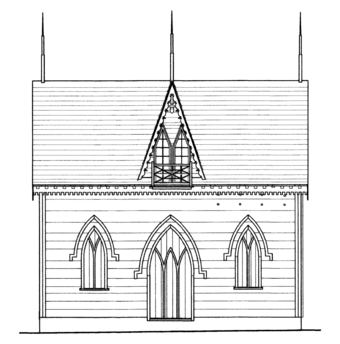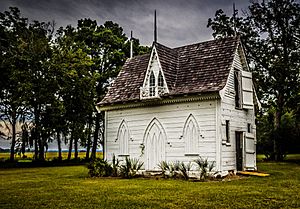Botany Bay Plantation Wildlife Management Area facts for kids
Quick facts for kids Botany Bay Heritage Preserve |
|
|---|---|
|
IUCN Category V (Protected Landscape/Seascape)
|
|

Botany Bay Rd.
|
The Botany Bay Plantation Wildlife Management Area is a special natural preserve located on Edisto Island, South Carolina. This large area was created in the 1930s by joining two older plantations: Sea Cloud Plantation and Bleak Hall Plantation. In 1977, the land was given to the state to protect its wildlife. It finally opened to the public in 2008.
The preserve is home to many important historical sites. These include old buildings from Bleak Hall Plantation, built around the 1840s. It also has the ancient Fig Island shell rings, which are thousands of years old. Both of these sites are listed on the National Register of Historic Places, meaning they are very important to American history.
Contents
History of the Land
Sea Cloud Plantation's Beginnings
The story of this land goes back a long time. In 1695, a man named Christopher Hinkley received a grant for 170 acres on Edisto Island. Later, in 1727, Paul Hamilton Sr. bought the property. His son, Paul Hamilton Jr., took over in 1748.
After the American Revolutionary War, another piece of land, about 21 acres, was added. This land was bought by Normand McLeod. Eventually, Ephraim Mikell Seabrook owned the property. Around 1825, he built a house there. Some people think the name "Sea Cloud Plantation" came from a marriage between a Seabrook and a McLeod family member.
Bleak Hall Plantation's Story
In the late 1790s, Daniel Townsend III started developing Bleak Hall Plantation. His first son, John Townsend, was born there in 1799. Around 1805, a large mansion was built on the property. John Townsend inherited the plantation around 1842. At some point in the 1840s, he also bought the Sea Cloud Plantation, combining the two properties.
John Townsend was a well-known farmer and leader in South Carolina during the 1800s. He grew a lot of Sea Island Cotton, which was a very valuable type of cotton. His cotton was so good that lace-makers in Belgium and France paid high prices for it. It even won several awards for its quality and length.
From 1822 to 1858, Townsend served many terms in the South Carolina General Assembly, which is like the state's government. In the early 1860s, he was part of a big meeting called the Secession Convention. At this meeting, South Carolina decided to leave the United States. This decision was one of the events that led to the American Civil War.
In November 1861, people living on Edisto Island had to leave because of the war. During the Civil War, both Union and Confederate soldiers used the tall tower on top of the Bleak Hall plantation house as a lookout point. The house later burned down during or shortly after the war. A new house was built in a mix of Victorian styles. The war had messed up property records, so Townsend had to ask U.S. president Andrew Johnson to confirm he still owned the land.
Townsend passed away at Bleak Hall in 1881. The plantation kept producing valuable Sea Island cotton until 1917. That's when the boll weevil, a tiny insect that destroys cotton plants, arrived on Edisto Island. By the early 1920s, cotton farming stopped. The plantation was then used for other types of farming and for growing timber.
Botany Bay Plantation is Formed
The Bleak Hall and Sea Cloud plantations stayed in the Townsend family until 1933. That's when Dr. James C. Greenway bought them. He combined the two properties and named the new, larger area "Botany Bay Plantation."
In 1968, a businessman named John E. "Jason" Meyer bought Botany Bay. He loved the outdoors very much. Meyer decided to give the 4,630-acre plantation to the state of South Carolina to be a wildlife preserve. However, he made one condition: if he passed away before his wife Margaret, she would get to live on and use the property.
John Meyer died in 1977. His widow, Margaret Pepper, continued to live on the plantation. She worked hard to protect and improve the land for conservation until she passed away in 2007. In 2008, the property finally opened to the public. It is now called the "Botany Bay Plantation Heritage Preserve/Wildlife Management Area" and is managed by the South Carolina Department of Natural Resources.
Protecting History
Bleak Hall Outbuildings
Three old buildings from the Bleak Hall Plantation are still standing at the Botany Bay preserve. They are believed to have been built around the 1840s. In 1973, these buildings were added to the National Register of Historic Places. This is because they are connected to John Townsend and are good examples of the Gothic Revival architecture style used on the plantation.
One of these buildings is an icehouse. It's a 1 1/2-story building made of wood, with a basement that has walls made of tabby (a type of concrete made from oyster shells). The icehouse has a tall, pointed roof. On the east and west sides, there are triangular dormers, each with two pointed windows and a small balcony. Wooden spires, like tall, thin towers, rise from the peaks of the roof and dormers. The roof edges are slightly curved. Decorative wooden boards with circular designs are found under the roof edges.
Close to the icehouse is a small tabby building. People think it was used as a gardener's shed or a smokehouse. This building has one door and no windows. Its roof is slightly bell-shaped, covered with cypress shingles, and topped with a wooden decoration. A board with large, jagged teeth-like designs runs around the building under the roof.
A short distance from these two buildings, near where the original Bleak Hall house once stood, is another tabby building. This one is thought to have been a barn during the Colonial period. Later, it was used as a shed for equipment. This building has a tall, pointed roof covered in cypress shingles. Wooden spires with decorations rise from each end of the roof. Decorative boards with teeth-like designs are under the roof edges. There are doors on the north and south sides of the building.
Near the icehouse and the gardener's shed are the remains of John Townsend's Japanese garden. In 1855, an expedition returned from Japan with a person named Oqui. Oqui was described as a "Japanese botanist" or "gardener." When Townsend heard about this, he traveled to Washington, D.C. He convinced Oqui to come back to South Carolina with him. There, Oqui helped design beautiful Oriental gardens. Even today, some parts of these gardens and some of the unusual plants still exist.
The Botany Bay Plantation WMA has 21 other registered historic sites. These include the remains of the Sea Cloud plantation house and a beehive-shaped brick well. This well was originally built to provide water.
The Fig Island Shell Rings are also on the property. These ancient rings of shells are estimated to be between 3,000 and 5,000 years old. They are also listed on the National Register of Historic Places.
Wildlife and Nature
Botany Bay Plantation WMA has many different types of natural areas. About 2,500 acres are made up of wetlands, which are areas covered by water. This includes 2 miles of beachfront. This beach is a very important nesting spot for endangered loggerhead sea turtles and least terns, which are small birds.
Another 1,847 acres are upland areas, mostly covered by forests with a mix of pine and hardwood trees. There are also 283 acres of farm fields. These fields are managed for hunting doves and as food sources for other wildlife. A system of dikes (walls that control water) creates both freshwater and brackish (slightly salty) ponds.





